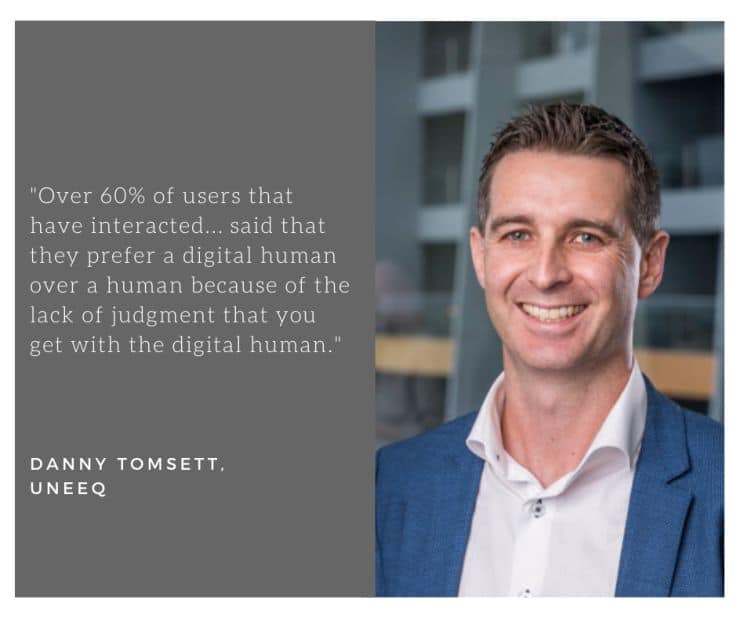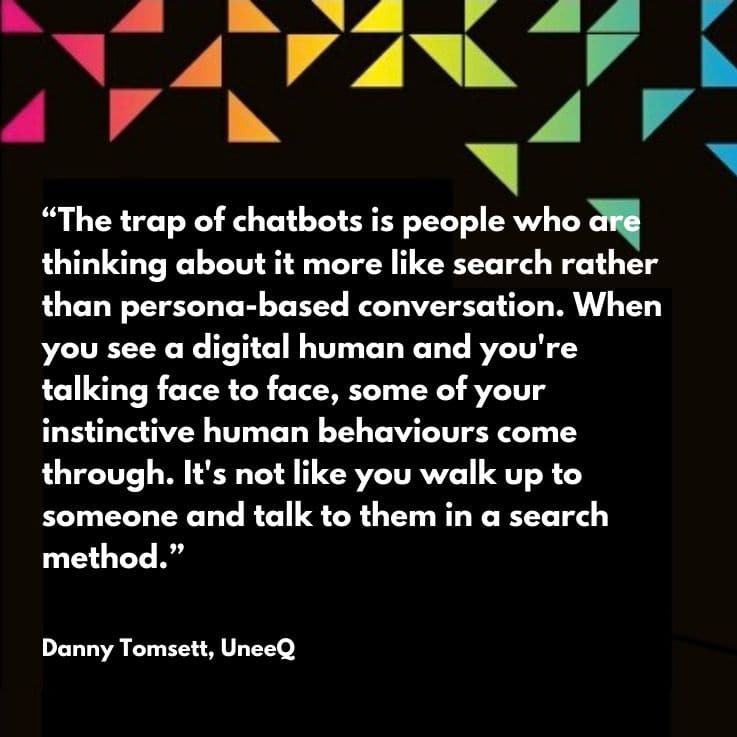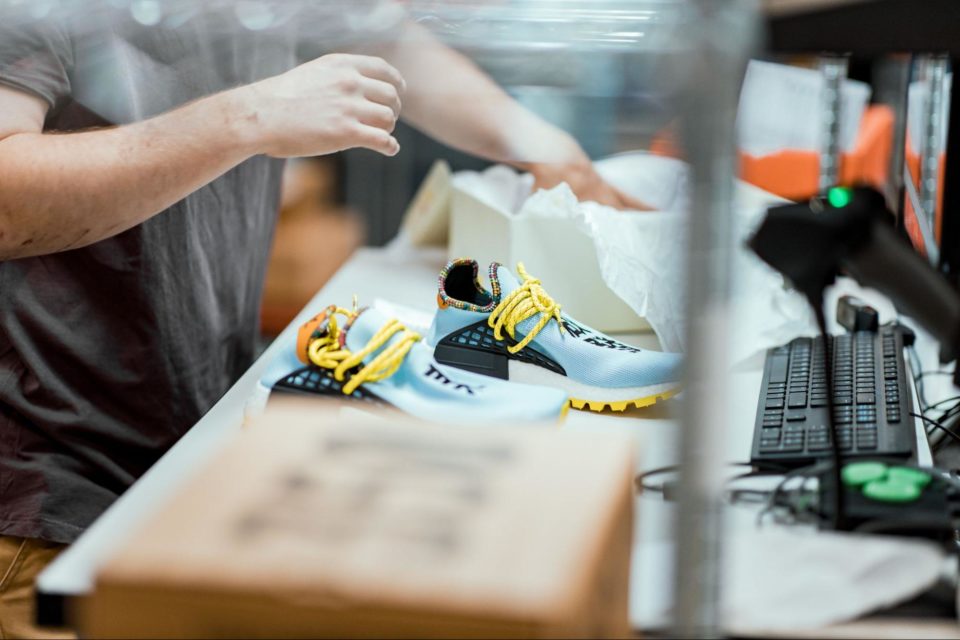How UneeQ is making the human touch digital


The importance of human interaction is widely acknowledged. For all the tech in the world, sometimes you just want to be able to talk to another person.
If you’re a business though, that human touch costs a lot of money. It can also be hard to scale in terms of the level of expertise or consistency of experience. It’s why you can get good or bad customer service from the same brand, or store, depending on who you interact with and through what channel.
UneeQ might be one way for brands to have the best of both worlds. It wants to make that human touch digital via its platform for creating digital humans. Using AI, these brand ambassadors can recreate the best aspects of human interaction in driving emotional connection – wherever and whenever the customer is.
We spoke to founder and CEO Danny Tomsett to find out how digital humans differ from other conversational options and how they might change the way we shop.
Danny Tomsett, CEO and founder, UneeQ
Can you give us an introduction to what you do?
UneeQ Digital Humans is a platform that allows any creator to develop and build an experience that uses a digital human to interact with customers.
A digital human is a lifelike human avatar that sits inside any browser, any mobile app, any kiosk and can see you and hear you and respond in the most natural ways to your questions, but also your emotions and other things like that.
When did the company begin?
The business started in 2010 as a way of solving the problem – how do you create emotional connection through digital channels in this new digital first society that we live in?
We created technology that could connect human to human with a single click and primarily from browser into contact centre. In 2015 we pivoted the business and started building out a digital human prototype.
What kind of businesses do you work with?
It’s quite interesting. Part of our journey was discovering which verticals and industries would gain the most value and have the highest interest in what we’re doing.
What we quickly learnt was that human touch is ubiquitous and a lot of enterprise market companies, in particular, are really struggling with how they deliver human touch at scale. They’ve got a need to deliver digital solutions because of cost of serve and meeting the customer expectation of always on 24/7, consistent and compliant experience.
They’ve got this big pot of challenges around how do you scale consistent, reliable, great customer experience where human touch is the key factor. Combine that with how do you converge that with great brand experience and digital channels and you’re left with a whole lot of large enterprise customers who are very attracted using these technologies.
We’ve worked with banks, insurers, telecommunications companies, healthcare providers, government, as well as retail with companies like Vodafone and The Warehouse Group.

What is the difference between the digital human and the chatbot?
The execution of a chatbot often isn’t a limitation of the technology. Whilst there are limitations of AI and natural language today, they continue to get much better and more effective at switching context and understanding.
Often the problem is more around the design thinking in how a customer experience should operate through conversation versus traditional thinking, which is knowledge based. The trap of chatbots is people who are thinking about it more like search rather than persona-based conversation.
One of the first things when we introduce digital humans is that you stop thinking about the experience of search. When you see a digital human and you’re talking face to face, some of your instinctive human behaviours come through. It’s not like you walk up to someone and talk to them in a search method.
You start conversing and therefore your design of conversation is now being thought of as a conversation vs a search type interaction. That makes a big difference. The customers who do that best get amazing outcomes with up to four times higher conversion rates because they’re able to create emotional connections.
Emotional connection is really about activating your right brain. Most of our engagement through digital is left brain interaction. It’s very logic driven. For us to truly impact someone with an experience that makes them smile or feel we need to engage the right brain of that person.
Therefore, what digital humans need to do really well is they need to be able to very quickly take text and turn that into a natural way of responding and use body language, the non-verbal interaction, to relax and connect with the individual. To do that, you need to be very good at training the AI around understanding what text is being sent to our APIs and how to speak and how to behave. It’s the little subtle things like how you listen to someone as that changes your demeanour as well.
One of my favourite metrics that we track is that over 90% of people interacting are still smiling on interaction. It’s such an interesting metric when you think about the impact and everything related to what a smile does inside your body and then how that connects subconsciously to your experience and how you connect with that brand.

How does the tech enhance the brand experience?
Organisations have had brand ambassadors for some time. Think about Ronald McDonald or Geico Gecko, for example. But what hasn’t existed is the convergence of advertising using brand ambassadors and the most common touchpoint which is customer service.
We get our customers thinking ‘if this is a common touchpoint for our customers, how do we represent our values and our brand in that experience with our customer – whether it be online or in a store, mobile, etc.’
They build these brand ambassadors as digital humans, and they design them to best represent friendliness, care, value, empathy. It might be a little bit quirky because they’re a quirkier brand. All those persona traits that often are best represented through their people have now been removed through digital channels and now are able to be created with these new brand ambassadors.

Where in retail do you see the potential for digital humans?
I’m very interested in retail because there are three particular trends that are happening right now which are very relevant.
The first one is omnichannel – how do you create an experience across all channels that’s consistent and personalised to that particular individual? If I’m in store and I’m talking to a digital human about a product or getting advice and I go home, that conversation can be continued at a convenient time on any device for me. I think that’s very powerful. The convergence of a customer journey across many channels is one of those particular areas I think digital humans will do very well in.
The second area is around large retailers like a Home Depot or a Wal-Mart, who have thousands of products and are representing so many brands. The challenge that the manufacturers have is that you have a limited amount of knowledge in-store to best represent your products, particularly when they’ve got challenging technical or other features that aren’t easily understood by the market.
Often these retailers have got one or two really good experts in-store, but you’re not always going to get access to them, and those roles churn all the time. We’re looking at how we provide product advice in a store – whether that’s scanning a QR code and talking to a digital human or a more kiosk-based type experience with a tablet next to each aisle.
The physical store now holds the opportunity to be an experience centre. But how are they redefining experience? How are you going to create feeling and everything else that goes with the importance of that experience factor? I like the thought of how that could play out with digital humans.
The third one is creating brand ambassadors that people connect to. We’re actually seeing existing celebrities and brand ambassadors becoming digital clones and being available as the brand ambassador for products online to support customers with the buyer journey.
It’s quite exciting when you think about the impact that that has from the retailers’ perspective where they’re obviously making quite large investments with a lot of these celebrity ambassadors typically from an advertising marketing point of view. Now they can connect that customer journey from seeing the ad to interacting with that celebrity on a website or a mobile app.
When you think about either the individual that is being cloned or a new character you create that people really follow and like, I think that’s where digital humans will become quite mainstream as well.
Is it a challenge to communicate what you do to the wider world?
It’s definitely a challenge. It’s a very early adopter market and like any emerging technology if you leave it up to people to imagine what you’re trying to describe it can actually vary quite widely as well.
However, it is one of those technologies, to our advantage, that you can show and is interactive. You can get it quite fast through the ability to interact. The challenge still exists to be able to do that at scale and for people to understand it.
For us that’s partly doing a really good job with our customers who have the confidence to get alongside us and experiment and prove it out. It’s early days, but we’re able to generate really great value for them.
It also needs to continue to drive value even when it’s not new. We want to continue to invest in increasing the experience and the capability of what digital humans can do.

How accepting do you think people will be of digital humans?
One of the interesting things is that we have customers in Japan and Singapore, and in those particular markets the acceptance of and preference for customers to interact and use it is very, very high.
Over 60% of users that have interacted and answered questions said that they prefer a digital human over a human because of the lack of judgment that you get with the digital human.
One of the biggest challenges is for people to progress with a buying decision or to engage with a company. That is sometimes derailed because they’re embarrassed to ask the dumb questions or what they perceive as dumb.
When they feel free to ask questions with no judgment, not only will they be helped and progressed into happy customers and paying customers, but the real value part for the organisation is they get to understand a whole lot more about their customers that they never did before and can refine a lot of their business model to actually cater for those things.
What is next for the business?
It’s definitely the iterations of improving the technology – helping the technology to become more affordable and more effective in engaging customers in natural ways and connecting to them through behaviour.
We’re very passionate about empowering creators who are experts in their own fields to use our technology easily and to deploy that to solve all sorts of problems. We’d love to see it be used more for healthcare and education. We’d love to see it be used even in home care and other areas like mental health.
Our platform actually does both characters as well as humans. We think there are some exciting things to come around how characters can be used as well. A big part of our product investment is to really drive towards enabling that.
Images courtesy of UneeQ



